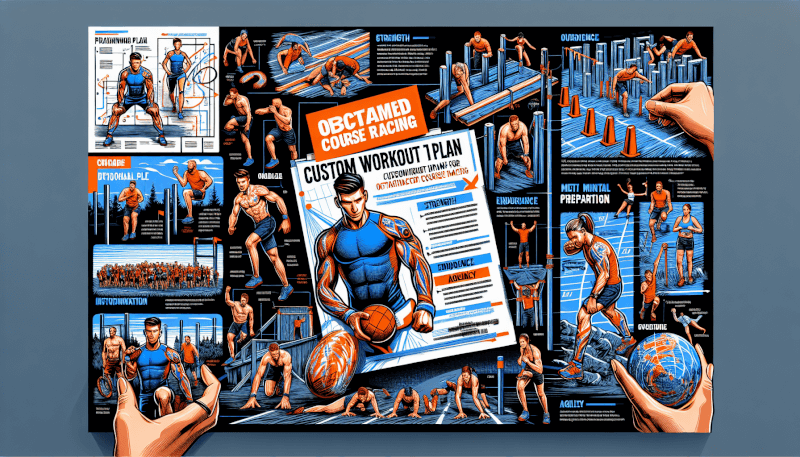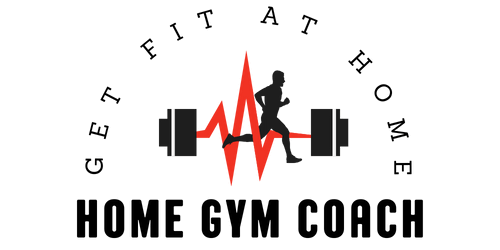Are you ready to take your obstacle course racing (OCR) training to the next level? Look no further! In this article, you will discover the benefits of custom workout plans specifically tailored for OCR enthusiasts like yourself. Whether you are a seasoned competitor or just starting out, these personalized training routines will help you improve your strength, endurance, and agility, allowing you to conquer any obstacle that comes your way. Get ready to unleash your full potential and achieve new levels of success in the exciting world of OCR!

Understanding Obstacle Course Racing
Obstacle course racing (OCR) has gained immense popularity in recent years, attracting participants of all fitness levels and backgrounds. OCR combines the thrill of endurance running with the challenge of overcoming various obstacles, testing your strength, agility, and mental toughness. Whether you’re a seasoned athlete looking for a new challenge or a beginner just starting your fitness journey, obstacle course racing offers a unique and exhilarating experience.
Different types of obstacle course races
Obstacle course races come in various formats, each with its own set of challenges and obstacles. Some popular types of OCR include:
- Spartan Race: Known for its demanding courses and signature obstacles like rope climbs, spear throws, and wall jumps.
- Tough Mudder: Features military-style obstacles and emphasizes teamwork and camaraderie.
- Warrior Dash: A beginner-friendly OCR with shorter distances and approachable obstacles.
- Savage Race: Offers intense challenges like mud trenches, high walls, and heavy carries.
These are just a few examples, but the variety of OCR events ensures that there’s something for everyone. Whether you prefer shorter, fast-paced races or longer, endurance-based events, you can find a race that suits your interests and fitness level.
Benefits of obstacle course racing
Engaging in obstacle course racing provides numerous physical, mental, and social benefits. Here are some advantages that make OCR a worthwhile pursuit:
- Full-body workout: OCR involves a combination of cardiovascular exercise, strength training, and functional movements, making it a comprehensive workout for your entire body.
- Increased strength and endurance: The challenging nature of OCR helps build muscular strength and endurance, as well as cardiovascular fitness.
- Mental resilience: Overcoming obstacles and pushing yourself outside of your comfort zone during OCR races can boost your mental toughness and self-confidence.
- Variety and excitement: Unlike traditional workouts, OCR offers a dynamic and ever-changing environment, keeping your fitness routine fresh and exciting.
- Strong sense of community: OCR events foster a sense of camaraderie and teamwork, as participants often help each other tackle obstacles and celebrate their achievements together.
Understanding the different types of obstacle course races and recognizing the benefits they offer sets the stage for customizing your workout plan specifically tailored to OCR.
Importance of Custom Workout Plans
Embarking on an obstacle course racing journey requires more than just showing up on race day and hoping for the best. To maximize your performance and reduce the risk of injury, it’s crucial to follow a custom workout plan designed specifically for OCR.
The role of fitness in obstacle course racing
OCR demands a well-rounded level of fitness that encompasses endurance, strength, agility, and mental resilience. A comprehensive workout plan ensures that you target all these areas effectively, allowing you to conquer the challenges presented by the course and obstacles.
Why custom workout plans are necessary
Every individual has unique fitness levels, strengths, weaknesses, and goals. A custom workout plan takes these factors into account, helping you address your specific needs and work towards improving your performance in OCR. By following a tailored plan, you can optimize your training time, focus on areas that require attention, and progress at a pace that is suitable for your abilities.

Assessing Your Fitness Level
Before diving into a custom workout plan, it’s essential to assess your current fitness level. This evaluation will help you understand where you stand and identify areas that need improvement.
Evaluating your current fitness
Start by assessing your cardiovascular endurance, muscular strength, agility, and flexibility. Perform a 1-mile run to gauge your running speed and stamina. Test your upper body and core strength through exercises like push-ups and planks. Check your agility and mobility through movements like lunges and squats. Finally, assess your flexibility through stretches like toe touches or the sit-and-reach test.
Identifying strengths and weaknesses
Once you’ve evaluated your fitness, identify your strengths and weaknesses. Maybe you excel in running but struggle with upper body strength. Or perhaps you have excellent grip strength but lack agility. Recognizing these areas empowers you to focus on them during your training and create a workout plan that tackles your weaknesses head-on.
Creating a Custom Workout Plan
Now that you have assessed your fitness level, it’s time to create a custom workout plan tailored to your specific needs and goals.
Setting specific goals
Begin by setting clear and measurable goals for your OCR journey. What are you aiming to achieve? Do you want to improve your overall speed, overcome specific obstacles, or increase your endurance? Setting specific goals helps you stay motivated, focused, and accountable throughout your training.
Choosing the right exercises
Based on your goals and areas for improvement, select exercises that target the necessary muscle groups and skills. Incorporate a mix of cardiovascular exercises, strength training, flexibility and mobility exercises, and obstacle-specific training. This variety ensures that you work on all aspects needed for OCR success.
Programming for endurance and strength
Your custom workout plan should incorporate both endurance and strength training. Endurance-focused exercises like running, rowing, or cycling build stamina and cardiovascular fitness. Strength training exercises such as squats, deadlifts, and pull-ups increase muscular strength and power.
Incorporating skill-specific training
To conquer the specific obstacles encountered in OCR, incorporate skill-specific training into your plan. If rope climbing is a weakness, practice rope climbs regularly. If you struggle with balance and agility, include exercises like single-leg squats or agility ladder drills. By dedicating time to skill development, you’ll enhance your ability to overcome race-specific challenges.
Allowing for recovery and rest
Remember to prioritize recovery and rest days in your custom workout plan. Rest is crucial to prevent overtraining and reduce the risk of injury. Allow your body time to recover and adapt to the physical demands of your training. Use rest days for light stretching, foam rolling, or low-intensity activities like yoga or swimming.

Components of an Effective Workout Plan
An effective OCR workout plan incorporates various components to ensure comprehensive training for the race day challenges.
Cardiovascular training
To build endurance for OCR, focus on cardiovascular exercises that elevate your heart rate for sustained periods. Running, cycling, swimming, and rowing are great choices. Incorporate both steady-state cardio sessions and interval training to improve aerobic and anaerobic fitness.
Strength training
Complement your cardiovascular training with strength exercises that target all major muscle groups. Compound movements like squats, deadlifts, and overhead presses engage multiple muscles simultaneously, mimicking the demands of OCR. Additionally, include exercises that target specific muscle groups needed for various obstacles, such as pull-ups for upper body strength.
Flexibility and mobility exercises
OCR requires a wide range of motion and flexibility. Include exercises that improve flexibility and mobility, like dynamic stretches and yoga poses. These exercises enhance your ability to tackle obstacles, prevent injuries, and improve overall performance.
Obstacle-specific training
Dedicate specific training sessions to replicate the challenges you’ll face during OCR. Incorporate exercises that simulate climbing, crawling, jumping, and carrying heavy objects. Practice tackling different types of obstacles to build familiarity and confidence.
Injury prevention exercises
To minimize the risk of injuries, incorporate exercises that strengthen the muscles and joints prone to injury in OCR. Exercises that target core stability, balance, and joint strength, such as planks, lateral lunges, and single-leg exercises, can help prevent common OCR injuries.
By incorporating these components into your custom workout plan, you’ll build a strong foundation for OCR success.
Building Endurance for Obstacle Course Racing
Endurance is a crucial aspect of obstacle course racing, as the courses often span several kilometers and require sustained effort. Here’s how you can develop endurance to excel in OCR.
Developing aerobic endurance
Aerobic endurance forms the foundation of OCR performance. Aim for sustained moderate-intensity cardio sessions like long-distance runs, cycling, or rowing. Start with shorter distances and gradually increase the duration and intensity of your workouts over time. As your aerobic endurance improves, you’ll be able to maintain a steady pace throughout the race.
Interval training for anaerobic endurance
OCR also demands bursts of high-intensity effort, making anaerobic endurance training essential. Incorporate interval training into your workouts to improve your ability to push through short periods of intense effort, such as sprinting between obstacles. Alternate between high-intensity intervals and recovery periods to simulate the demands of OCR.
Using hill training to build strength and stamina
Hill training is a valuable tool for building strength and stamina specific to OCR. Find a local hill or incline and incorporate uphill sprints or hill repeats into your training. Running uphill engages different muscles, increases cardiovascular stress, and challenges your endurance capabilities. It also simulates the variable terrain often encountered during OCR races.
By consistently working on aerobic and anaerobic endurance, as well as incorporating hill training, you’ll develop the stamina necessary to conquer the challenges of OCR.

Strength Training for Obstacle Course Racing
Building strength is essential for tackling the various physical obstacles encountered in OCR. Incorporate the following elements into your strength training routine.
Compound exercises for full-body strength
Compound exercises recruit multiple muscle groups simultaneously, making them an excellent choice for OCR strength training. Squats, deadlifts, lunges, and bench presses are examples of compound exercises that help build overall strength and power.
Targeting specific muscle groups
In addition to full-body exercises, include exercises that target specific muscle groups crucial for OCR performance. Focus on strengthening your grip, upper body (especially the back, shoulders, and arms), and core. Pull-ups, farmer’s carries, and hanging leg raises are effective choices for targeting these areas.
Implementing bodyweight exercises
Bodyweight exercises are valuable in OCR training, as they mimic the demands of overcoming obstacles using your own body weight. Include exercises like push-ups, burpees, pull-ups, and box jumps to develop functional strength and endurance.
Incorporating functional training
OCR requires functional strength that translates into real-world movements. Incorporate functional training exercises like kettlebell swings, battle ropes, and sled pushes to improve muscular endurance, power, and stability.
By implementing a well-rounded strength training routine, you’ll enhance your ability to conquer the physical challenges presented by OCR.
Skill-Specific Training
To excel in obstacle course racing, it’s vital to devote time to skill-specific training. Here are some skills to focus on during your training.
Mastering rope climbing
Rope climbing is a common obstacle in OCR, requiring upper body strength and technique. Practice rope climbs regularly to improve your grip strength and develop efficient climbing techniques. Start with lower heights and gradually work your way up as you gain strength and confidence.
Improving grip strength
OCR obstacles often involve grip strength challenges, such as monkey bars or rope traverses. Enhance your grip strength by incorporating exercises like dead hangs, farmer’s carries, and grip trainers into your training routine. Progressively increase the difficulty and duration of these exercises to continually push your grip strength.
Practicing balance and agility
Maintaining balance and agility is critical when navigating various OCR obstacles. Incorporate exercises that improve proprioception, such as single-leg exercises, agility ladder drills, and balance board training. These exercises enhance your stability and coordination, making it easier to conquer obstacles that require precise movements.
Enhancing obstacle technique
Research and practice specific techniques for tackling common OCR obstacles. For example, learn proper technique for traversing monkey bars or efficiently completing a spear throw. Understanding the best approaches to obstacles can save time and energy during the race.
By dedicating time to skill-specific training, you’ll become better equipped to handle the technical challenges OCR presents.

Injury Prevention and Recovery
Injury prevention and recovery are crucial aspects of any OCR training plan. Incorporate the following practices to minimize the risk of injuries and ensure your body stays in optimal condition.
Importance of injury prevention
Striving to prevent injuries should be a priority in OCR training. The demanding nature of the sport places stress on your body, making it more susceptible to strains, sprains, and other injuries. By incorporating injury prevention strategies, you can reduce the likelihood of setbacks and stay on track with your training.
Proper warm-up and cool-down routines
Start each workout with a thorough warm-up that includes dynamic stretches, mobility exercises, and light cardio. A proper warm-up primes your muscles and joints for the upcoming activity, reducing the risk of injury. Cool down with static stretches and gentle movements to gradually decrease your heart rate and promote recovery.
Incorporating mobility and flexibility exercises
Maintaining good mobility and flexibility is essential for injury prevention and improved performance. Incorporate exercises that target mobility, such as hip openers, shoulder mobility drills, and thoracic spine rotations. Stretch regularly to improve flexibility in key areas like the hamstrings, hips, and shoulders.
Importance of rest and recovery
While training for OCR requires commitment and hard work, it’s equally vital to give your body time to rest and recover. Adequate rest allows your body to repair and adapt to the demands of training, reducing the risk of overuse injuries and burnout. Plan regular rest days and prioritize sleep to optimize your recovery process.
By prioritizing injury prevention practices and allowing for proper recovery, you’ll set yourself up for a successful OCR journey.
Monitoring and Adjusting Your Plan
Once you have a custom workout plan in place, it’s important to regularly monitor your progress and make adjustments as necessary.
Tracking progress and performance
Regularly monitor your progress by tracking key metrics like running times, repetitions completed, and weight lifted. This allows you to see improvements over time and stay motivated. Keep a training journal or use digital tools like fitness apps to record your workouts and monitor your progress.
Making adjustments based on feedback
As you progress in your OCR training, pay attention to your body’s response and adjust your plan accordingly. If you find that you’re consistently fatigued or experiencing persistent muscular soreness, consider incorporating more rest days or altering the intensity and volume of your workouts. Listen to your body and make adjustments that support your overall well-being.
Periodizing your training for peak performance
To optimize your performance on race day, consider implementing periodization into your training plan. Periodization involves dividing your training into distinct phases, each targeting different aspects of fitness. This approach ensures that you peak at the right time and avoid overtraining. Work with a qualified coach or trainer to design a periodized plan that aligns with your goals and race schedule.
By monitoring your progress, making adjustments based on feedback, and implementing periodization, you’ll continually refine your training plan and maximize your potential in OCR.
In conclusion, custom workout plans are essential for success in obstacle course racing. By understanding the different types of OCR, recognizing the benefits, assessing your fitness level, and creating a tailored workout plan, you can train effectively and optimize your performance. Incorporate components such as cardiovascular training, strength training, skill-specific training, and injury prevention strategies into your plan. Regularly monitor your progress, make adjustments as needed, and prioritize rest and recovery. With dedication and a well-structured custom workout plan, you’ll be well-prepared for the challenges that await you in obstacle course racing.


